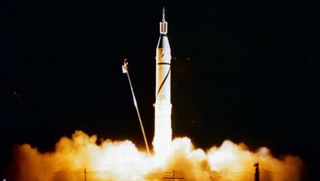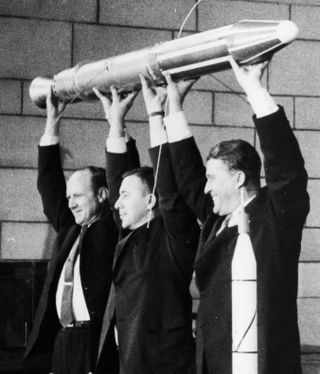Happy Anniversary, Explorer 1! 1st US Satellite Launched 60 Years Ago Today
The United States became a spacefaring nation 60 years ago today.
On Jan. 31, 1958, the nation launched its first successful satellite — Explorer 1, which rode to Earth orbit atop a Jupiter-C rocket from Florida's Cape Canaveral Missile Annex (now called Cape Canaveral Air Force Station).
“We have firmly established our foothold in space," rocket pioneer Wernher von Braun, who led the team that designed the Jupiter-C, said shortly after Explorer 1 made it to space. "We will never give it up." [Explorer 1: The First American Satellite in Pictures]
The success of Explorer 1 soothed a lot of jangled nerves among the American political and military elite, who had recently endured three humbling space setbacks.

The first two jolts came courtesy of the Soviet Union, which launched the first-ever artificial satellite, Sputnik 1, on Oct. 4, 1957, and followed that up a month later by lofting a dog named Laika to orbit, aboard the Sputnik 2 craft.
Get the Space.com Newsletter
Breaking space news, the latest updates on rocket launches, skywatching events and more!
The United States tried to answer on Dec. 6, 1957, with a satellite launch of its own. But the rocket carrying the nation's first would-be spacecraft, the 3.5-lb. (1.6 kilograms) Vanguard Test Vehicle 3, burst into flames shortly after liftoff, live on national TV.
So, the Explorer 1 launch "certainly salved the open wound; there's no doubt about that," former NASA Chief Historian Roger Launius told Space.com last fall.
But the 30.7-lb. (13.9 kg) Explorer 1 was not just a space-race publicity stunt; the satellite performed groundbreaking science work as it orbited Earth. It spotted fewer high-energy cosmic rays than expected, leading Explorer 1 principal investigator James Van Allen to suggest that the satellite's detector had been overwhelmed by charged particles trapped in Earth's magnetic field. [Space Race: Could the U.S. Have Beaten the Soviets into Space?]
Van Allen was right. The Explorer 3 spacecraft, which launched on March 26, 1958, confirmed the existence of these bands of radiation, which are now known as the Van Allen belts. (Explorer 2 had launched three weeks earlier but failed to reach orbit because of a rocket malfunction.)
The satellite was designed and built by engineers at the Jet Propulsion Laboratory (JPL) in Pasadena, California. Today, JPL is one of NASA's flagship centers, but NASA didn't even exist when Explorer 1 lifted off; the space agency was officially established six months later, on July 29, 1958, and began operations on Oct. 1 of that year.

Explorer 1 zoomed around Earth on a highly elliptical, 114-minute-long path that took it as close as 220 miles (354 kilometers) to Earth, and as far away as 1,563 miles (2,515 km). The satellite kept operating for nearly four months, blinking out when its batteries died on May 23, 1958. And it finally fell back to Earth on March 31, 1970, burning up in the atmosphere after completing more than 58,000 orbits, NASA officials said.
The space race kept ratcheting up after Explorer 1. The Soviet Union was first to launch a person to space, when cosmonaut Yuri Gagarin lifted off on an orbital mission on April 12, 1961. The United States matched this feat the following February, with John Glenn's orbital mission. (Alan Shepard became the first American in space on May 5, 1961, but his flight was suborbital, not orbital.)
And, of course, NASA ended up making good on President John F. Kennedy's famous promise to put boots on the moon by the end of the 1960s. We'll celebrate the 50th anniversary of Apollo 11's spectacular achievement in July 2019.
Follow Mike Wall on Twitter @michaeldwall and Google+. Follow us @Spacedotcom, Facebook or Google+. Originally published on Space.com.
Join our Space Forums to keep talking space on the latest missions, night sky and more! And if you have a news tip, correction or comment, let us know at: community@space.com.

Michael Wall is a Senior Space Writer with Space.com and joined the team in 2010. He primarily covers exoplanets, spaceflight and military space, but has been known to dabble in the space art beat. His book about the search for alien life, "Out There," was published on Nov. 13, 2018. Before becoming a science writer, Michael worked as a herpetologist and wildlife biologist. He has a Ph.D. in evolutionary biology from the University of Sydney, Australia, a bachelor's degree from the University of Arizona, and a graduate certificate in science writing from the University of California, Santa Cruz. To find out what his latest project is, you can follow Michael on Twitter.
